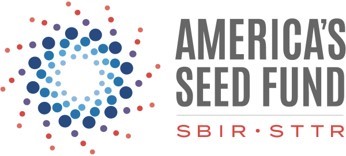Acknowledgment of support statement: Funded in part through a Cooperative Agreement with the U.S. Small Business Administration. All opinions, conclusions, and/or recommendations expressed herein are those of the author(s) and do not necessarily reflect the views of the SBA.

Entrepreneurs and small businesses sometimes struggle with securing funding and navigating the regulatory requirements to get their innovation off the ground. Parallax Advanced Research and its affiliate the Ohio Aerospace Institute (OAI) provide support for early-stage companies in identifying and pursuing traditional and non-traditional sources of debt and equity and granting capital to fuel their growth and innovation. OAI was once again awarded a contract from the US Small Business Administration’s Federal and State Technology (FAST) Partnership Program to promote the Small Business Innovation Research (SBIR) Program. OAI’s objective is to increase awareness of the SBIR program to encourage small businesses to apply for federal SBIR grants and assist them in the pursuit of funding. The program places particular emphasis on socially and economically disadvantaged firms. Ron Stubblefield, senior program manager within our Tech Based-Economic Development (TBED) group, shared his insights about the funding opportunities and services Parallax and OAI offer.
UNDERSTANDING TECH BASED ECONOMIC DEVELOPMENT
TBED refers to a strategy focused on driving economic growth by actively promoting the development and adoption of new technologies, creating innovative industries, and fostering a climate where technology companies can thrive, differentiating itself from traditional economic development efforts by prioritizing innovation and technological advancements as the primary driver of economic growth, rather than solely relying on established industries or resource extraction. What separates TBED from other economic development strategies is that other strategies have a major focus on business attraction, retention and expansion and are often place based. TBED, however, is more innovation focused. For these reasons, the TBED strategy typically consists of the following:
Focus on Innovation: TBED places a strong emphasis on research and development (R&D), encouraging the creation of new technologies based on R&D and their application across various sectors, whereas traditional economic development typically focuses on attracting companies and retaining existing businesses to a region.
High-Skill Workforce Development: TBED necessitates a skilled workforce capable of developing and utilizing advanced technologies, requiring significant investments in education and training programs focused on STEM fields.
Startup Ecosystem Support: TBED actively supports the growth of technology startups through initiatives like venture capital funding, incubators, and access to networks, fostering a dynamic environment for new businesses.
Specialized Technical Facilities & Digital Infrastructure Development: To facilitate tech innovation, TBED emphasizes the need for specialized technical facilities such as sensitive compartmented information facilities (SCIFs) and biolabs, or robust digital infrastructure like high-speed internet, cloud computing capabilities, and data centers.
Global Competitiveness: Due to the rapid pace of technological change, TBED often involves strategies to stay competitive in the global market by attracting international talent and fostering collaborations with leading tech companies.

SBIR/STTR AND THE FAST PROGRAM: A LAUNCHPAD FOR INNOVATION
The SBIR and Small Business Technology Transfer (STTR) programs serve as vital funding mechanisms for entrepreneurs. Unlike traditional equity funding, SBIR and STTR grants are non-dilutive, allowing businesses to retain full ownership while pursuing innovation. The goal of this program is to help bring innovations to the market that also help a government agency fulfill its mission. Eleven agencies participate in this program in some form. These programs are designed to help a company do three things:
Develop a proof of concept of their innovation-typically a $50-275K award over a 6-12-month period (Phase I).
Conduct further technology development of their innovation after demonstrating a proof of concept-typically a $750k-$1.8M award over a 24-month period (Phase II).
Commercialize their technology-take their innovation to market.
The goal of this program is to help bring innovations to the market that also help a government agency fulfill its mission. Eleven agencies participate in this program in some form.
THE FAST PROGRAM: EMPOWERING ENTREPENEURS
Recognizing the challenges many entrepreneurs and small business owners have in navigating and applying for SBIR/STTR funds, the SBA’s FAST Partnership Program provides funding to organizations to execute state/regional programs that increase the number of SBIR/STTR proposals leading to an increase in the number of SBIR/STTR awards from women, socially/economically disadvantaged individuals, and small businesses in underrepresented areas - typically rural states. OAI has again won the FAST contract and operates programs for to assist Ohio entrepreneurs. Key initiatives include:
Outreach: Increase the pipeline of SBIR/STTR applicants through training and outreach; and build the capacity of partner organizations and individuals to support SBIR/STTR applicants and existing awardees.
Technical and business assistance: Support entrepreneurs and startups through programs or services that improve proposal development and team creation; provide assistance that leads to the commercialization of technology developed through SBIR/STTR program funding; and form or encourage relevant mentoring networks to provide business advice and counseling.
Financial support: Make grants or loans to applicants to pay a portion or all the cost of developing SBIR/STTR proposals (Phase 0), attending relevant conferences, and bridging gaps between phases.
THE PARALLAX/OAI ROLE IN SUPPORTING AEROSPACE INNOVATION
Small companies and startups in the areas we serve, such as the aerospace and defense industries, often face challenges like securing funding, navigating complex supply chains, intense competition from larger established players, hiring highly specialized talent, managing high development costs, dealing with stringent regulatory requirements, and adapting to rapid technological advancements.
We are uniquely positioned to help small businesses overcome these obstacles and succeed in a competitive industry. At Parallax and OAI, we provide SBIR/STTR assistance through FAST and the APEX Program, grant writing assistance via the ESP Program with the State of Ohio (Dayton and JumpStart), tech transfer support, workforce development programs (such as aerospace workforce development), supply chain collaborations, and tech scouting. Parallax also manages the OFRN Program for the State of Ohio and the Defense Innovation OnRamp Hub: Ohio, which offer unique pathways and access to working with the federal government. Other ways in which we can assist include:
Connection to program managers at federal agencies.
Proposal writing support and assistance.
Technical and business assistance-ranging from market research, IP strategy, funding strategy.
Operational support for SBIR/STTR winners.
Connections to capital access partners.
The intersection of our TBED and SBIR/STTR services presents a winning formula for innovation and economic growth in the aerospace sector. By providing expertise, supporting underrepresented entrepreneurs, and building robust ecosystems, Parallax and OAI together exemplify the impact that strategic partnerships and programs can have on small businesses.
To learn more or for further discussion, please contact Ron Stubblefield, Senior Program Manager – OAI Tech Based Economic Development, at RonaldStubblefield@oai.org

###
Parallax Advanced Research is a 501(c)(3) private nonprofit research institute that tackles global challenges through strategic partnerships with government, industry, and academia. It accelerates innovation, addresses critical global issues, and develops groundbreaking ideas with its partners. With offices in Ohio and Virginia, Parallax aims to deliver new solutions and speed them to market. In 2023, Parallax and the Ohio Aerospace Institute formed a collaborative affiliation to drive innovation and technological advancements in Ohio and for the nation. The Ohio Aerospace Institute plays a pivotal role in advancing the aerospace industry in Ohio and the nation by fostering collaborations between universities, aerospace industries, and government organizations, and managing aerospace research, education, and workforce development projects. More information on both organizations can be found at Parallax and OAI websites.
